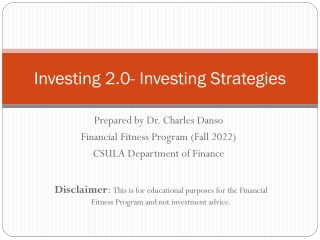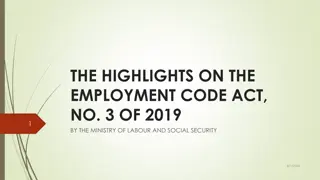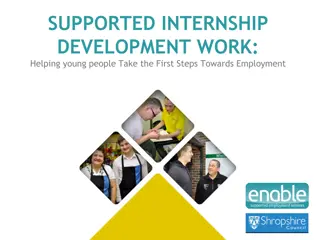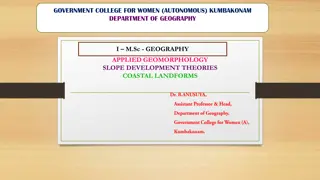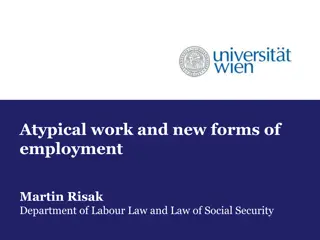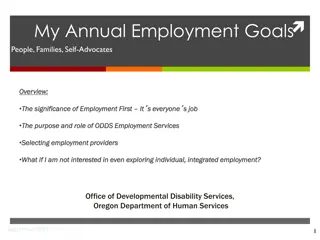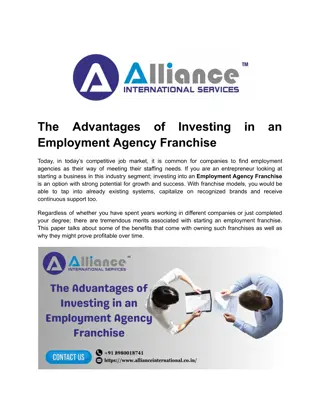Re-Investing in Supported Employment: Turning Tides and Future Perspectives
Initial investments in supported employment in the 1980s and 1990s paved the way for positive outcomes and policy developments, yet there remains uneven implementation across states. The journey from impossible to required standards for integrated employment highlights the need for renewed national investments in creating opportunities for all.
Download Presentation

Please find below an Image/Link to download the presentation.
The content on the website is provided AS IS for your information and personal use only. It may not be sold, licensed, or shared on other websites without obtaining consent from the author.If you encounter any issues during the download, it is possible that the publisher has removed the file from their server.
You are allowed to download the files provided on this website for personal or commercial use, subject to the condition that they are used lawfully. All files are the property of their respective owners.
The content on the website is provided AS IS for your information and personal use only. It may not be sold, licensed, or shared on other websites without obtaining consent from the author.
E N D
Presentation Transcript
Turning Tides: Re-Investing in the Future of Supported Employment David Mank, Ph.D. and Teresa Grossi, Ph.D. Indiana Institute on Disability and Community Indiana University www.iidc.indiana.edu APSE November, 2013
WORK: Intentional physical or mental effort directed toward the production or accomplishment of something, most often to benefit someone other than one s self.
Initial investments in the 1980s and 1990 s created an environment of possibility.
Supported employment emerged in federal law in 1984. P. L. 98-527
The history from the late 1970s to the present includes a host of developments and documentation of positive outcomes, development of improved methods, organizational approaches, systemic strategies, as well as policy and funding mechanisms.
There is an unevenness across states in the implementation of employment options.
There are about 20% of people in some day service with access to integrated employment, and this average has been much the same for nearly 20 years.
Employment From impossible to possible . From possible to beneficial . From beneficial to allowed . From allowed to preferred . From preferred to expected . From expected to required . . to the same standard as everyone else
Renewed National Scale Investment U. S. Department of Labor, Office of Disability Employment Policy Administration on Intellectual and Developmental Disabilities Department of Education Center for Medicare and Medicaid Services Social Security Administration
AND Alliance for Full Participation National Governor s Association Employment First Approaches
Improvements in Employment Implementation Supported Employment Methods Customized Employment Self-Employment Project Search Transition
Maximizing Individual Outcomes Excellent job match Maximum hours / week possible Neutral supports Benefits planning Personalize Take advantage of what is typical in a job setting
Funding Focused on Outcomes
New Information About Sheltered Settings Individual Choices Family Experiences Legislation
Ways to Diminish Outcomes Few hours day / week Group employment Sub-minimum wage Providers as employer of record Aggressive use of tax credits Protecting SSI/SSDI benefits
Did You Know That We Have Choice Of: Over 300 different types of cereals? Over 40 different types of toothpaste? Over 230 different types of soups?
Choice For Individuals: How many work experiences (paid or nonpaid) do individuals with disabilities typically have prior to a permanent job? How many experiences does it take before truly understanding a person s strengths, preferences, interests, and needs? How many opportunities prior to closing the case?
Arguments Against Expansion of Supported Employment People choose to congregate People are happy where they are Its too expensive The community is not a friendly place Some people aren t ready Some people are too severely disabled Supported Employment is simply a different not a better - paradigm
Renewed Business Leadership: Walgreens, Starbucks, BLN s and More
Litigation U. S. Department of Justice
Renewed Investment in Transition and Post Secondary Education
International Developments
Rising Voice of Self-Advocates (sabe.org)
Therefore, Be It Resolved Equal employment opportunities for equal pay for all people Immediately, no new people can go into sheltered workshops Immediately, no new people can go join an enclave Ending sub-minimum wage in 2012 Ending enclaves in 2014
Potential Threats to Further Expansion of Integrated Employment Funding Constraints: Hours of employment delivered for people that do get jobs Continued slow pace of expansion Benefits trap Sustained pressure in states to expand day services
Implications Policy Litigation Research Implementation Funding
A New Path to Change Do what we already know how to do Put control of resources in the hands of people with disabilities Eradicate policy conflicts Close the door of entry into segregated programs Expand investment with employers Invest in broader community initiatives


